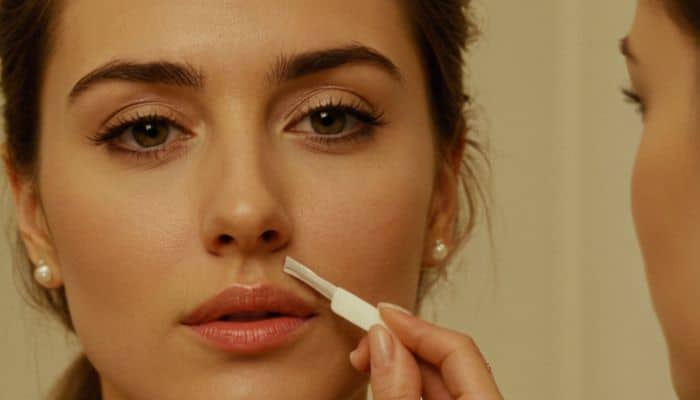Looking for effective ways to remove white facial hair? Hair growth can occur due to a number of reasons from hormonal changes to genetics. Unlike the hair on the other body parts, facial hair is quite visible and hard enough to deal with.
If you’re bothered by the hair that grows on your face and find it tedious to visit a salon every few weeks, here are some simple and effective ways to remove your facial hair naturally at home.
Facial Hair: Facts
Many people feel that removing facial hair is merely a cosmetic procedure, but there are numerous more reasons why it is necessary.
Anti-Aging Advantages
Shaving exfoliates and removes the skin’s outer layer, allowing new skin layers to emerge. The new skin layer is undeniably younger, with fewer wrinkles.
Removes Dark And Ingrown Hair
Dark and thick hair can grow in a variety of body areas, including the face and neck. Shaving on a regular basis may help to remove dark hair and ingrown hair. People with varied skin types can also easily eliminate facial hair using technology and gadgets.
Easy Makeup
Using a facial hair remover to eliminate unwanted hair will make applying makeup easier and smoother. Additionally, moisturizers, sunscreen, night cream, and other skincare products penetrate thoroughly on a hair-free face, supporting better skin. Furthermore, experts say that hair-free skin requires less time and effort to apply makeup.
Improves Self Confidence
Many of us find facial hair upsetting and uncomfortable. It can lead to feelings of inadequacy and shame, which can be emotionally draining. It can also cause itching skin and bacterial infections. When you don’t have to worry about facial hair growth, your self-confidence soars and you can show off your immaculate skin.
Effective Ways To Remove White Facial Hair

Here are some of the most effective ways to remove white facial hair.
1. Waxing
Waxing is one of the effective ways to remove facial hair. In this process, hot wax is applied to the facial area from which you want to remove the facial hair and then using a waxing strip you can rip off the facial hair from its roots.
Just remember, when you’re shopping for wax, look for soft wax, or wax that’s formulated for use on the face. If you choose a wax that needs to be warmed at home, purchase a wax warmer. A wax warmer will heat the wax evenly and allow you better control over the temperature.
Further, purchase plenty of waxing sticks to only use each stick once. “Double-dipping” can introduce bacteria into the wax and may cause a skin infection.
Follow these steps to wax your facial hair:
- Wash your hands.
- Clean and exfoliate your face.
- Apply the wax while holding the skin taut.
- Firmly remove the strip in the direction the hair grows.
- Now, remove the leftover wax with baby oil, then moisturize.
While waxing facial hair regularly can reduce its growth over time, it is also a painful method to undergo that can leave your skin feeling quite sensitive.

2. Epilation
Epilation is another effective option for removing facial hair. This may sound painful, but it is actually a relatively painless and mess-free way to remove hair when compared to waxing.
Epilators eliminate facial hair by grabbing multiple hairs at the same time and removing them from the root. Because hair is removed from the root, it takes longer to grow back. Sometimes, epilation results in hairs growing back softer and finer. Strands may become less noticeable.
To remove hair with an epilator, follow these steps:
- Hold the epilator at a 90-degree angle.
- Move the epilator in the direction of hair growth.
- Slowly glide the epilator over your face to avoid breaking the hair. Don’t press it too hard against your skin.
- Rinse off your face and pat dry.

3. Tweezing
Tweezing is another simple and effective way to remove facial hair. Tweezers are designed to pluck or pull hair from the roots. Tweezing your hair with stainless steel and sanitized tweezer can prevent it from growing back for at least 4-8 weeks.
To tweeze facial hair, follow these steps:
- Wipe your face with a warm washcloth to soften the skin.
- Isolate the hairs you want to pluck.
- While holding your skin taut, pluck one hair at a time.
- Always pull or pluck in the direction of hair growth.
- If you have pain, rub an ice cube over the area to reduce redness and inflammation.

4. Threading
Threading is probably the most common method of removing facial hair. Mostly this process is used for shaping eyebrows and removing unwanted facial hair on the upper lip, side of the face, and chin.
In this method, a length of thread is twisted between the thumbs and forefingers and is glided against the skin to remove the facial hair. The results can last longer than shaving or tweezing and this method doesn’t cause ingrown hairs.
As threading doesn’t involve chemicals, there’s no risk of a skin reaction, although you may experience minor discomfort during the process. To reduce pain, use numbing cream on your face, or apply a warm compress afterward. This method of hair removal requires skill, so you’ll need to find a trained cosmetologist or esthetician.
Also Read:
- How To Apply Eyeshadow Like A Pro – Complete Guide
- 8 Most Revealing Bathing Suits For Women
- 7 Best Extreme Push Up Swimwear
5. Shaving
Shaving is one of the fastest and easiest ways to remove facial hair. However, with this process, the results aren’t permanent or long-lasting. Your face will remain hair-free for one to three days, and then you’ll have to re-shave.
For the best results, clean your face and apply a layer of soap or shaving cream. This promotes a smooth surface and reduces the likelihood of cuts. Glide the shaver over your face in the direction of hair growth.
Keep in mind that while this method is relatively safe, ingrown hairs can be a side effect of shaving. These small bumps develop when hair grows back into the skin. Ingrown hairs usually improve on their own within days.

6. Hair Removal Creams
Depilatory creams also known as facial hair removal creams are probably the most effective and painless way of removing hair from your face. These creams contain potent chemicals that dissolve your hair, which can then be simply scraped or wiped away.
First, wash your face with warm water to soften the hair follicles. Then, apply a layer of the cream to the area where you want to remove the hair. Then, wipe the cream and hair away with a warm, damp wash cloth.

Conclusion
The best way to remove facial hair depends on your personal preferences, pain tolerance, skin sensitivity, and budget. Shaving, tweezing, and depilatory treatments are appropriate for short-term and low-cost solutions. Waxing, threading, and epilators can all provide long-lasting results. Laser hair removal and electrolysis are the most permanent choices, but they need greater financial commitment and dedication. Before starting a new hair removal routine, keep your skin type in mind and speak with a dermatologist if you have any concerns or skin conditions.
FAQs
What is the best way for permanent hair removal?
Electrolysis is the only FDA-approved method of permanent hair removal. Laser hair removal can also produce long-term results, though it might require extra treatments.
Does shaving facial hair make it grow back thicker or faster?
Shaving has no impact on the thickness, color, or growth rate of hair. It may appear thicker due to the blunt tip of the hair shaft after shaving.
How frequently should I remove facial hair?
This is dependent on the method used and your hair growth rate. Shaving may be required every few days, although waxing and threading can last for 2-4 weeks. Laser hair removal and electrolysis produce longer-lasting results.
Can I remove facial hair if my skin is sensitive?
Yes, but use methods that are gentle on the skin, such as threading, tweezing, or a depilatory product designed specifically for sensitive skin. Further, don’t forget to do a patch test first.
Are there any natural ways to remove facial hair?
Natural procedures, such as sugar waxing (sugaring), can be less painful than regular waxing. Homemade masks containing substances such as turmeric and gram flour are thought to slow hair growth over time, though their effectiveness varies.
Can hormonal changes impact facial hair growth?
Yes, hormonal changes such as puberty, pregnancy, menopause, and polycystic ovary syndrome (PCOS) can stimulate facial hair growth.
Disclosure: Bear in mind that some of the links in this post are affiliate links and if you go through them to make a purchase then this blog may receive a commission. Although we receive a commission for using and linking affiliate products, they are extremely good and all our opinion and suggestions are unbiased.




